by Texas Homesteader ~
How do you feed your honeybee hives during the cold winter months? It’s a different procedure than just feeding the sugar syrup like you do during warmer summer dearth months.
We easily make homemade honeybee candyboards to see them through the cold of winter.
(Note: Some links in this post will take you to other related articles for further information. But links preceded with * are affiliate links. If you click and buy something I could receive a tiny commission.)
At the end of this post is a list of all our beekeeping posts. It includes everything from obtaining your first hives, different hive split procedures, feeding, catching bee swarms, requeening etc. I encourage you to check out our Beekeeping Posts.
Today we’re talking about honeybee feeding during times when they may not be able to adequately feed themselves.
Such times as the dearth of summer or cold winter months when blooms are scarce or gone completely.
Summer Honeybee Hive Feeding
RancherMan and I have a small apiary with a few beehives. We work hard to keep the bees as healthy as possible.
In the dearth of summer when nothing’s blooming from which the bees can forage we supplement them a recommended measured sugar/water syrup mixture to see them through.
But what about winter months when that syrup would just freeze?
How To Feed Honeybees In The Winter
The best food for our honeybees is their own reserved honey. RancherMan and I inspect the hives in the fall to make sure that going into winter they have plenty of honey-filled frames to keep themselves fed until spring.
Plus, here in NE Texas our winters are pretty mild. So we often don’t have to supplement our bees at all in winter.
But one year we caught a small bee swarm pretty late in the year. They went into fall healthy but their numbers were still small. We wanted to make sure they had plenty of food during those cold winter months.
In the past our local beekeeper’s association had suggested that beekeepers supply dry sugar for honeybee winter food needs.
They recommended laying a sheet of black & white newspaper atop the brood box frames and pouring sugar directly onto the paper. We were told the condensation inside the hive would collect in the sugar and make it firm.
The beekeepers association members said the bees will eat through the newspaper and consume the sugar if needed.
It’s been marginally successful for us in past years. But this year I made them a candyboard instead and feel it was a better option.
A candyboard just basically a sugar/water mixture cooked into a fondant of sorts and allowed to harden before feeding the hardened sugar patty to the bees.
If we had *bee pollen and other additives we could add them in our candyboard as well. But today I’ll just be making the candyboard using only sugar and water.
Candyboard Mold Options
Some people use metal pie pans to make the honeybee candyboard (also known as honeybee fondant, sugar patty or sugarboard).
Others make it in a large flat pan and just score the fondant before it cools completely so they can break off any size candyboard chunk they need to feed their bees.
But I like to use larger dinner-sized paper plates.
Whatever form you use, you want to make sure the resulting hardened sugar patty is thin enough to fit beneath the lid of the top hive. This size requirement is a great benefit to using the larger paper plates.
I had some heavy white 10” paper plates so I used them. They will result in a candyboard that fits nicely on the top brood box and still allows the lid to close securely.
And the round shape is nice because it will sit in the center top of that brood box, allowing the bees to easily access it from all sides.
How Do You Prepare Candyboard Fondant Molds?
Before getting started you need to prepare the molds you’ll be using for your candyboard. The USU beekeeping page indicated that to prepare the surface for your sugar patty you should spray the form lightly with oil.
I did that this time, but wonder if I might try lining the paper plate with parchment paper next time so I don’t have to use the oil?
Now that my fondant molds are prepared it’s time to make our candyboard sugar patties to go in them to feed our honeybees.
Melting The Sugar For Honeybee Candyboard
I know that simmering sugar syrup can foam and bubble pretty heavily. So I used a larger stock pot to make sure there was plenty of room for the mixture to bubble & expand without making a mess on my stovetop.
Into my stock pot I added 16 ounces (2 cups) of water and brought it to a simmer. Then I added a full 4-lb bag of plain granulated sugar and stirred it into the water until the sugar was completely dissolved.
Now I bumped the stove burner temperature to medium high and let it heat up without stirring further. (Not stirring helps reduce the foaming.) As the sugar melts, the liquid will become translucent.
Without stirring, I boil the syrup until it reaches 235° F. That’s the soft-ball temperature required for candy making.
I used my instant read thermometer to check the temperatures since I don’t own an actual candy thermometer.
(The USU suggested boiling to 234° F but I often heat to 235° F to reach soft-ball temps. Not sure it makes much difference…)
When my fondant was ready I removed the pot from the heat and allowed it to cool until the fondant temperature dropped to 210° F. The cooling took about 16 minutes for me.
Beating Air Into Fondant
Once the candy cools to between 200 to 210°F I transferred the liquid to my KitchenAid stand mixer. Using the paddle attachment I slowly beat the mixture to add air to it.
The color of the candy changes from clear to white and crystallizes somewhat too.
If you’ll be adding *Pollen Substitute and/or *Honey B Healthy, you’ll add them when the temperature of the candy reaches 175°F.
(I didn’t add anything to mine – only sugar and water for my candyboards)
Now it’s time to form my sugar fondant patties.
Forming Candyboard Patties From Sugar Fondant
I placed the three prepared paper plates on my granite countertop since granite is a heat-proof surface. (If your countertops aren’t heat proof you might want to set cookie sheets on top of a hot pad to protect the surface beneath from the heat.)
I divided the 175° F fondant between the three plates. Then I allowed the candyboards to cool completely right there on my countertop.
Once they are completely cool I will place the now-rigid candyboard – plates and all – in a large ziplock bag.
The candyboards can be stored at room temperature for several weeks. If I need longer storage I can store them in the freezer.
Honeybee Winter Feeding Candyboard Fondant
It’s best for the bees to eat their reserved honey first. So I typically don’t want to feed candyboards until around mid January.
But we also don’t like to open the hives when it’s really cold outside because we don’t want to release any of the heat the bees have produced to keep the hive warm.
So around the first or second week of January we’ll pick a day when the lows the night before aren’t too cold and the daytime temperatures will be above 50 degrees F.
As with everything else here on the Homestead, it’s aaaaaaall about the weather!
When it’s time to feed my honeybee’s fondant to the hive I remove the paper plate and it’s ready to serve. I’ll be feeding directly on top of the frames in the top brood box of the hive.
I like to lay a piece of black and white newspaper on top of the frames and place the sugar patty on top of the paper. Maybe it’s needed, maybe it’s not.
But I feel as the bees eat the candy it may keep too much loose sugar from falling through the frames. As you see they will eat right through the paper to get to the candyboard.
Because I’ve made these fondant patties in paper plates they’re thin enough to sit nicely in the top center of the brood box and still allow the lid to fit securely.
The circular shape gives plenty of room for the bees to gather around it.
Now we wait for spring!
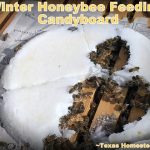
Honeybee Candyboard For Winter Feeding
Ingredients
Ingredients:
- 4 lbs. granulated sugar
- 2 cups water
- ¼ cup bee pollen optional
- 2 tbsp. Honeybee Healthy optional
Instructions
Preparing The Molds:
-
Spray three 10” paper plates lightly with oil. Set aside on heat-resistant surface or cookie sheet.
Cooking Candyboards:
-
In an oversized stock pot, add 16 oz (2 cups) of water to the pot and bring to a simmer over medium-high heat.
When water is simmering, carefully pour a full 4-lb bag of sugar into the water & stir until sugar is completely dissolved.
After sugar is dissolved continue to heat on medium high temperature without stirring. (Not stirring helps reduce the foaming.) As the sugar melts, the liquid will become translucent.
Without stirring, boil the syrup until it reaches 235° F, the soft-ball temperature required for candy making.
When fondant reaches 235° F, remove the pot from the heat and allow fondant to cool until the temperature drops to between between 200° F to 210° F. (about 16 minutes)
Beating Fondant:
-
Once the candy cools to between 200° F to 210° F , transfer the candy to a stand mixer. Using the paddle attachment, slowly beat the mixture to add air. The color of the candy will change from clear to white and crystallizes somewhat.
If you’re adding pollen and Honeybee Healthy you’ll want to add when the candy drops to a temperature of 175° F.
Forming Candyboards
-
Place the three prepared paper plates on a heat-proof surface such as a cookie sheet on top of a hot pad to protect the surface beneath from the heat.
Divide the 175° F fondant between the three plates. Then allow the candyboards to cool completely.
-
Once they are completely cool, place the candyboard plates in large zippered plastic bag. They can be stored at room temperature for several weeks. If you need longer storage I can keep them in the freezer.
~TxH~
BEEKEEPING SERIES:
- Preparing For the Hives
- Obtaining Your Bees
- Inspecting Your Hives
- Feeding Bees With A Frame-Feeder
- Knowing When To Expand The Hive
- Performing A Walk-Away Split
- Performing A Frame-Swap Split
- 5-Minute Beehive Stand
- Adding A Honey Super To Your Hive
- Catching A Bee Swarm (With Video)
- Requeening A Beehive – Things We Didn’t Know
- Make FOUR 5-Frame Nuc Boxes From 1 Sheet of Plywood!
- Varroa Mite Treatment For Your Apiary
- Preparing Your Hive For Honey Harvest
- Proper Honey Bottling Tips
- Purifying Your Beeswax
- MYO Beeswax Lip Balm
- Homemade Beeswax Jar Candles
- Beeswax Wraps – A Natural Solution To Plastic Wrap
- *Bee Pollen Honey Bee Supplement
- *Honey B Healthy Honey Bee Supplement
- *Pollen Substitute For Honey Bee Health
…And MUCH More!
See All Our Beekeeping Posts
C’mon by & sit a spell! Come hang out at our Facebook Page . It’s like sitting in a front porch rocker with a glass of cold iced tea. There are lots of good folks sharing! And you can also follow along on Pinterest, Twitter or Instagram
If you’d like to receive an email when a new blog post goes live,
subscribe to our Blog!
Reference:
Utah State University – Bee Nutrition

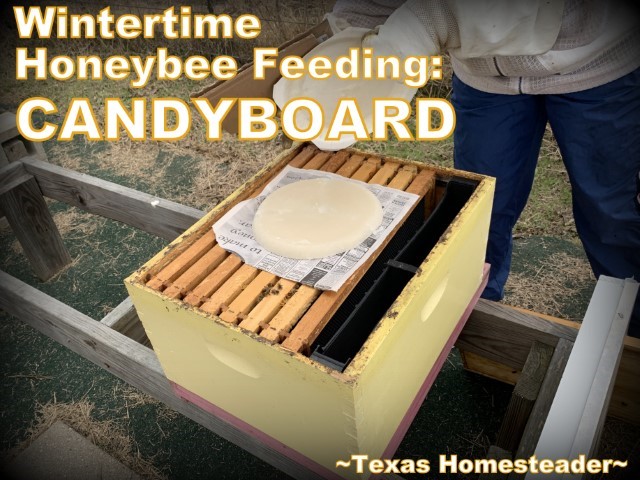
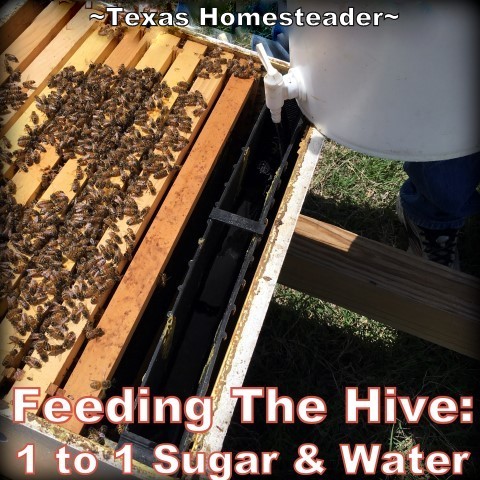
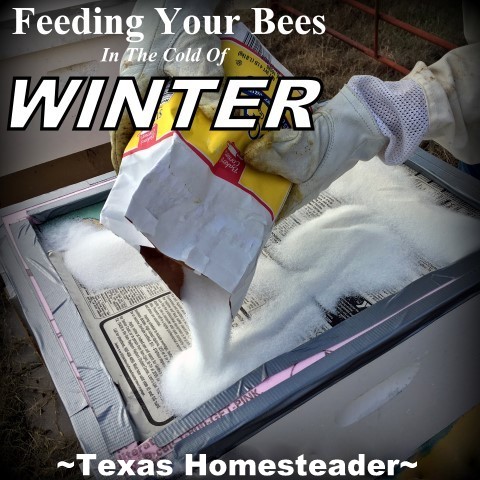
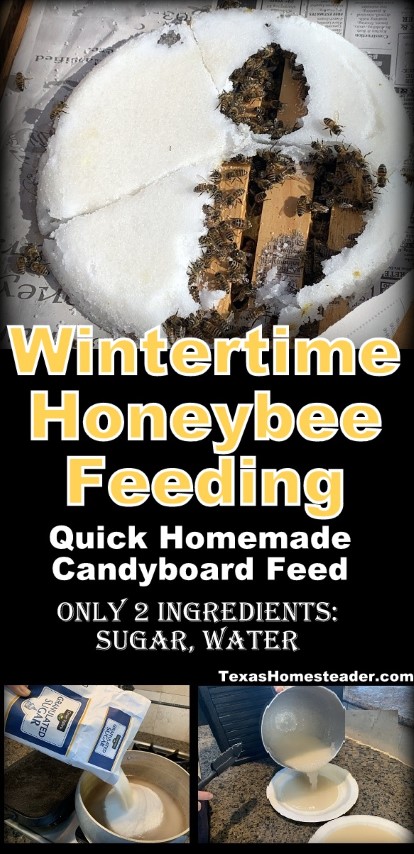
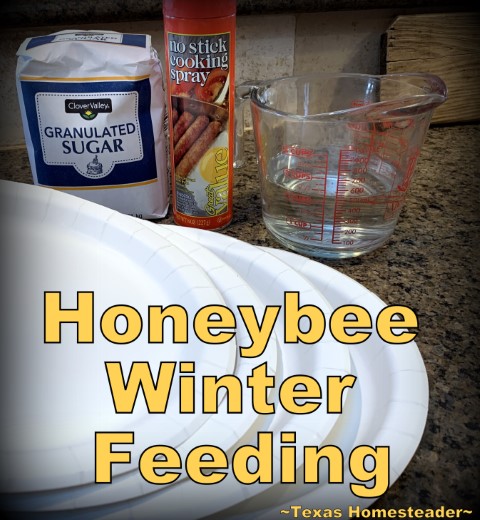
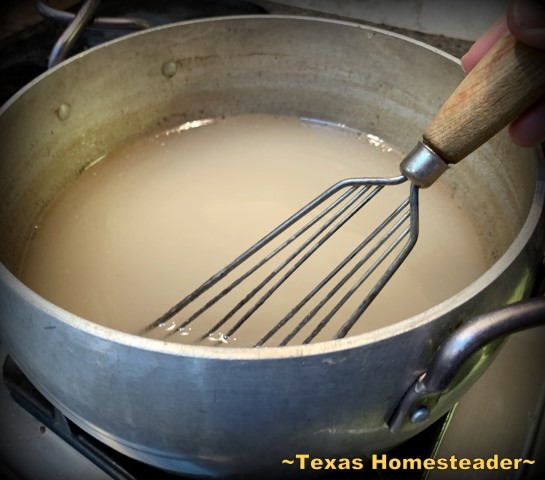
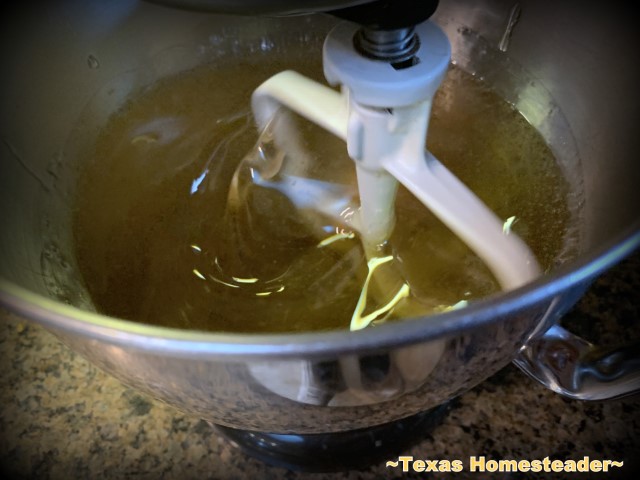
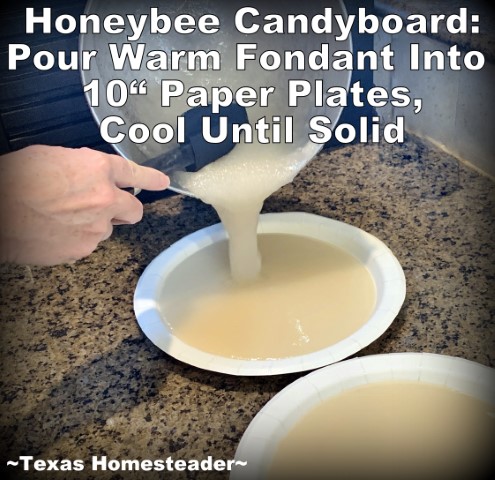
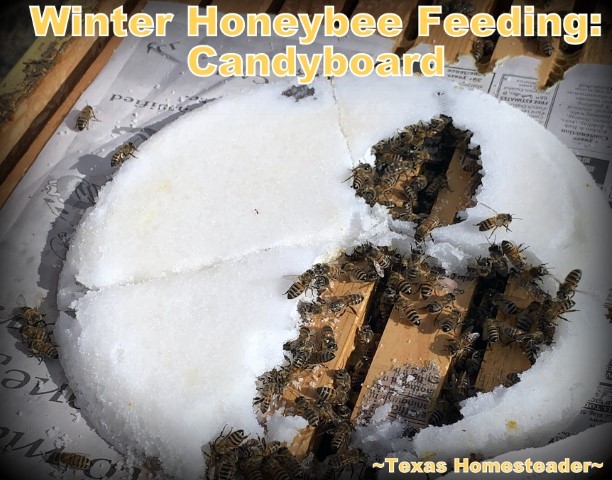
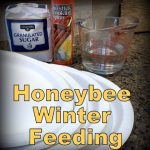
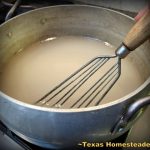
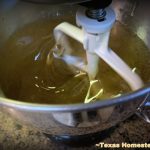
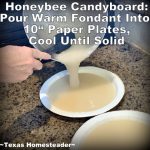


I don’t keep bees but others in my area do (Texas hill country). I do see honey bees throughout the year of course – I love the sound of them as they visit my flowering plants in the summer, especially the rosemary right outside my kitchen. Do you know of anything a non bee-keeper can do in the winter for those that visit? Thanks for the wonderful information you share!
Depending upon your ‘off-season’ weather, any blooms from which the bees can harvest is a good thing, although honeybees don’t typically leave the hive when it’s cold (under 40-45 degrees F typically). We don’t have much blooming here in NE Texas during the winter months. They do harvest from dandelions in the early spring around here so we see that and colder-weather clovers as an important food source for our honeybees. As you mentioned, honeybees love most herb blooms too. And equally important for anyone wanting to help the bees – no poisons! Insecticides, even ‘natural’ ones, kill bees. Thank you Patty for caring about those precious pollinators! ~TxH~